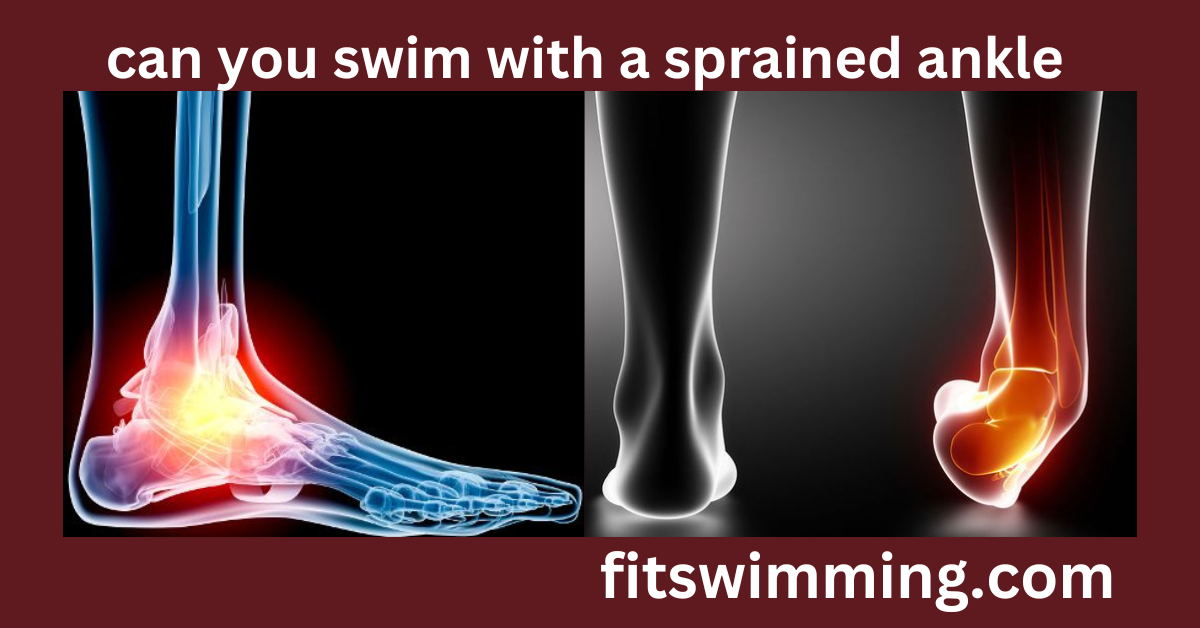Can You Swim with a Sprained Ankle? Precautions and Benefits
One of my teammates had fractured his ankle in a road accident. He was very fond of swimming. In a meeting, he insisted me to swim. One question raised in my mind “Can you swim with a sprained ankle”. So I advised him to see healthcare first because of the ankle injury. And we started doing deep research on it. Read this article from start to end to know everything about this.
In this guide, we will find out if swimming is okay for people with a sprained ankle and learn about important things to be careful about. While swimming can offer certain benefits during the recovery process. It’s essential to approach it with caution to prevent further injury and promote healing. Let’s dive in to understand the precautions you should take and the potential benefits swimming can provide when dealing with a sprained ankle.
Can You Swim with a Sprained Ankle?
It’s usually not a good idea to swim when you have a broken ankle. A broken ankle happens when one or more bones in your ankle are cracked or fractured. Swimming can put pressure on the injured area and make the injury worse. Swimming involves movement and pressure on the ankle joint, which can worsen the injury, cause pain, and potentially delay the healing process.
Go for medical attention if you suspect a fractured ankle. A healthcare professional will diagnose the fracture and provide appropriate treatment, which may involve immobilization, casting, or surgery, depending on the severity of the fracture.
During the initial stages of a fractured ankle, it is important to prioritize rest, allow the bones to heal, and follow the guidance of your healthcare provider. Engaging in swimming or any other physical activity that places stress on the fractured ankle can lead to complications and hinder the recovery process. Below are some factors which we need to keep in mind.

Factors to Consider
Before deciding whether to swim with a sprained ankle, several important factors should be taken into account:
The severity of the sprain
How bad the sprained ankle is will affect whether you can do physical activities, like swimming. Mild sprains may allow for modified swimming exercises, while severe sprains might require complete rest.
Medical advice
Seeking professional medical advice is crucial. Consult with a healthcare professional to evaluate the severity of the sprain, rule out any underlying fractures or complications, and receive personalized guidance.
Personal comfort and pain tolerance
Every individual experiences pain differently. Assess your personal comfort level and pain tolerance when considering swimming with a sprained ankle. If the pain worsens during or after swimming, it may be a sign to avoid or modify your swimming routine.
Swimming environment
Consider the swimming environment and its potential impact on your sprained ankle. Factors such as water temperature, current, pool depth, and accessibility to support structures should be evaluated for safety and comfort.
Benefits of Swimming with a Sprained Ankle
Swimming can offer potential benefits for those with a sprained ankle, including:
Non-Weight bearing exercise
Swimming provides a low-impact, non-weight-bearing exercise option, reducing stress on the injured ankle while allowing for cardiovascular activity and muscle engagement.
Improved circulation and reduced swelling
The water’s buoyancy can aid in reducing swelling and enhancing blood circulation, promoting the healing process.
Maintaining cardiovascular fitness
Swimming enables you to maintain cardiovascular fitness levels during the recovery period when other forms of exercise may be limited.
Strengthening surrounding muscles
Engaging in controlled swimming exercises can help strengthen the muscles surrounding the sprained ankle, aiding in overall recovery and preventing muscle atrophy.
Precautions and Recommendations
While swimming with a sprained ankle can have potential benefits, it is crucial to take precautions and follow these recommendations.
Consult with a healthcare professional
Obtain medical advice and clear your decision to swim with your healthcare professional, ensuring it aligns with your specific situation.
Support and protective measures
Utilize ankle braces, wraps, or waterproof supports to stabilize the ankle and provide additional protection during swimming.
Modified swimming techniques
Adapt your swimming techniques to minimize strain on the injured ankle. Focus on strokes that do not excessively stress the ankle, such as using a kickboard or emphasizing upper body movements.
Listen to your body
If swimming causes increased pain or discomfort, it may be best to avoid or modify your swimming routine until the ankle has healed further.
DOES SWIMMING HELP WITH SPRAINS
Swimming is often thought of as a good way to help with sprains, but it’s not always the best option. It can actually make things worse by putting more strain on your injured ligaments and increasing the risk of getting waterlogged. If you have a sprain, it’s better to do gentle exercises like walking or using crutches instead.
Both swimming and walking can be helpful for recovering from strains, sprains, and tears. Being in the water has many benefits for your body when you’re injured, such as improved blood flow, reduced pain, and less swelling.
The ideal water temperature for doing exercises to help with your recovery is between 86 and 90 degrees Fahrenheit. This temperature helps make your muscles more flexible, improves your range of motion, and reduces inflammation.
Being in the water can make you heal faster by giving warmth and moisture to the injured area. It also gives a feeling of safety, which may help people heal faster compared to just sitting or lying down alone.
Can You Swim with a Fractured Ankle
It’s usually not a good idea to swim when you have a broken ankle. If you have a fractured ankle, it means that one or more bones in your ankle are broken. Swimming involves movement and pressure on the ankle joint, which can worsen the injury, cause pain, and potentially delay the healing process.
In case of a fractured ankle, consult your healthcare on an urgent basis. A healthcare professional will diagnose the fracture and provide appropriate treatment, which may involve immobilization, casting, or surgery, depending on the severity of the fracture.
During the initial stages of a fractured ankle, it is important to prioritize rest, allow the bones to heal, and follow the guidance of your healthcare provider. Engaging in swimming or any other physical activity that places stress on the fractured ankle can lead to complications and hinder the recovery process.
Always take advice from your healthcare professional in this situation. They can provide guidance on when it is safe to resume swimming or any other physical activities after a fractured ankle, based on the progress of your healing and the advice of your healthcare team.
Conclusion: Can You Swim with a Sprained Ankle? Precautions and Benefits
Swimming with a sprained ankle can be possible under certain circumstances, but it requires careful consideration and adherence to precautions. Ultimately, your decision should be based on the severity of the sprain, medical advice, personal comfort, and the swimming environment. Always prioritize your health and consult with healthcare professionals to ensure a safe and effective recovery from a sprained ankle. Now we are going to have a look at swimming in the rain.
FAQ’s
Swimming can be beneficial for a sprained ankle as it provides a low-impact, non-weight-bearing exercise option. The water reduces the stress on joints and can help improve circulation and can cause to reduce swelling. However, it is important to consult with a healthcare qualified and listen to your body to ensure it is safe for your specific situation.
With a sprained ankle, you should avoid putting weight on it, engaging in strenuous activities, jumping, running, and any movements that can worsen the injury or cause pain.
No, it is generally not recommended to swim with a fractured ankle. Swimming involves movements and pressure on the ankle joint, which can worsen the injury and cause more pain. It’s important to allow the fractured ankle to heal properly before attempting any swimming activities.
To help your sprained ankle heal faster, you can follow these steps:
Rest: Give your ankle proper rest and stop extra activities.
Ice: Put ice on your ankle for 15 to 20 minutes every few hours. This helps to decrease swelling and reduce pain.
Compression: Wrap your ankle with a stretchy bandage or wrap to give it support and help decrease swelling.
Range of Motion Exercises: Perform gentle exercises to improve ankle mobility and prevent stiffness.
Supportive Devices: If your healthcare professional suggests it, you can use special ankle supports like braces, crutches, or a walking boot to help your ankle heal and provide extra support.
Physical Therapy: Consider seeking physical therapy to promote healing and strengthen the ankle.







